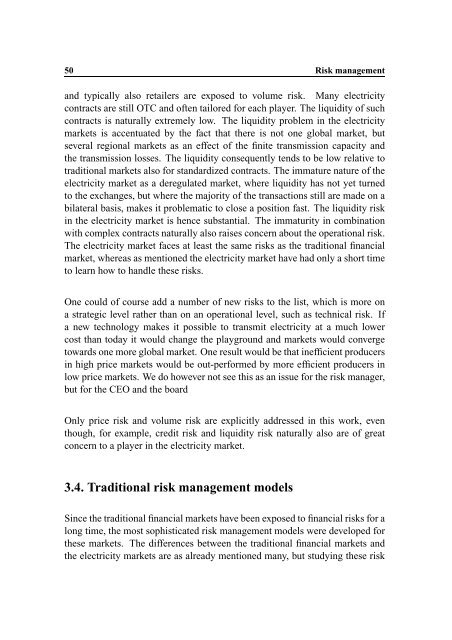Hedging Strategy and Electricity Contract Engineering - IFOR
Hedging Strategy and Electricity Contract Engineering - IFOR
Hedging Strategy and Electricity Contract Engineering - IFOR
Create successful ePaper yourself
Turn your PDF publications into a flip-book with our unique Google optimized e-Paper software.
50 Risk management<br />
<strong>and</strong> typically also retailers are exposed to volume risk. Many electricity<br />
contracts are still OTC <strong>and</strong> often tailored for each player. The liquidity of such<br />
contracts is naturally extremely low. The liquidity problem in the electricity<br />
markets is accentuated by the fact that there is not one global market, but<br />
several regional markets as an effect of the finite transmission capacity <strong>and</strong><br />
the transmission losses. The liquidity consequently tends to be low relative to<br />
traditional markets also for st<strong>and</strong>ardized contracts. The immature nature of the<br />
electricity market as a deregulated market, where liquidity has not yet turned<br />
to the exchanges, but where the majority of the transactions still are made on a<br />
bilateral basis, makes it problematic to close a position fast. The liquidity risk<br />
in the electricity market is hence substantial. The immaturity in combination<br />
with complex contracts naturally also raises concern about the operational risk.<br />
The electricity market faces at least the same risks as the traditional financial<br />
market, whereas as mentioned the electricity market have had only a short time<br />
to learn how to h<strong>and</strong>le these risks.<br />
One could of course add a number of new risks to the list, which is more on<br />
a strategic level rather than on an operational level, such as technical risk. If<br />
a new technology makes it possible to transmit electricity at a much lower<br />
cost than today it would change the playground <strong>and</strong> markets would converge<br />
towards one more global market. One result would be that inefficient producers<br />
in high price markets would be out-performed by more efficient producers in<br />
low price markets. We do however not see this as an issue for the risk manager,<br />
but for the CEO <strong>and</strong> the board<br />
Only price risk <strong>and</strong> volume risk are explicitly addressed in this work, even<br />
though, for example, credit risk <strong>and</strong> liquidity risk naturally also are of great<br />
concern to a player in the electricity market.<br />
3.4. Traditional risk management models<br />
Since the traditional financial markets have been exposed to financial risks for a<br />
long time, the most sophisticated risk management models were developed for<br />
these markets. The differences between the traditional financial markets <strong>and</strong><br />
the electricity markets are as already mentioned many, but studying these risk
















